How to prevent knee or back pain from gardening
If you’re heading out into the garden after the winter, you need to take steps to prevent knee or back pain.
You may be longing to get out there – but as soon as you get stuck in, all the old ominous twinges come back.
Kesson Physiotherapy in Kent say that when the gardening season starts, when everyone rings up on a Monday morning with knee or back pain from gardening.
But much of the pain in both your back and knees can be prevented or managed.
And in order to find out more, I interviewed Denise Kesson of Kesson Physiotherapy.
Do you need warm-up exercises before gardening?
Some people suggest that doing a pre-gardening warm-up with exercises would help. It undoubtedly would.
But when you’re trying to fit gardening into a busy life, it’s not always practical.
Luckily Denise doesn’t think you need to warm up with formal exercises. ‘Walk round the garden a few times, checking out what you need to do. Collect up your kit and do some easy, quick jobs first. Just getting moving will help.’
The jobs that will give you back pain from gardening
Bending or working at an awkward angle could give you back or knee pain. For example, Denise says that it’s important to think about the height of your potting bench. ‘If you’re re-potting or working for too long in a hunched-over position, that can give you a bad back. And if you’re lopping your own trees, then pulling or dragging heavy branches at any awkward angle, you can hurt your back.’
Then there’s digging, carrying heavy sacks of stuff and wheel-barrowing. Not to mention moving large pots.
And it’s not just your back that suffers when you over-load the wheelbarrow, sack or pot. If you’re carrying over uneven ground, it will also put pressure and lack of balance on your knees, according to Denise.
So time yourself!
The best way of preventing back pain from gardening, according to Denise, is not to do too much of each task at once. Especially at the beginning of the season or if you can only garden at weekends.
If, for example, you’re re-potting some seedlings and planting them out, don’t spend 40 minutes in the potting shed, then forty minutes planting seedlings out.
Spend fifteen minutes in the potting shed, then fifteen minutes planting the seedlings out, then perhaps fifteen minutes on another job if you can. Then you can go back to the potting shed.
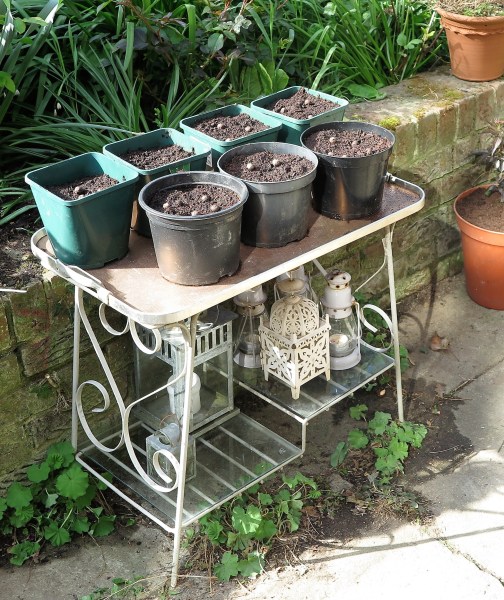
Beware of potting up and planting seeds hunched over a table that is too low.
Denise also advises changing positions if you can: ‘There isn’t necessarily a bad position to work in. You’re most likely to get trouble by staying any one position for too long.’
I’ve accidentally followed this policy for many years because it’s also an effective way of fitting gardening in. If I feel too busy to garden, I set my mobile phone timer to 15 minutes.
My reasoning is that I won’t miss 15 minutes out of my day. And if I garden for 15 minutes a day four times a week, that’s an hour’s gardening. Or four hours gardening a month. Which goes quite a long way in a middle-sized garden.
Soon you’ll be able to do more
And, if you garden regularly, your muscles adapt to the gardening tasks. So if you do carry on for longer one day, you’re much more likely to do it safely, says Denise.
I have certainly noticed that I can now ignore the timer and keep going. Just lifting a spade used to give me sciatica. Now I can fill and empty a barrowful of compost. That is because I have always gardened little and often.
However, I appreciate that gardening in 15 minute snatches isn’t an option if you work in an office and only see your garden at weekends in the winter. Or if you have to travel half an hour to an allotment.
In which case, there is a fine traditional British habit of spending more time leaning on your spade chatting to people than actually gardening. Gossiping is good for your back.
And I’ve also found that doing a weekly Pilates class is a huge help, too.
Easy tricks to avoid gardening back pain
I use a lightweight ‘Garden Life’ spade from Kent & Stowe. Its smaller, lighter spade head means it takes less earth or compost. So not only is the spade itself lighter, but it lifts a lighter load.
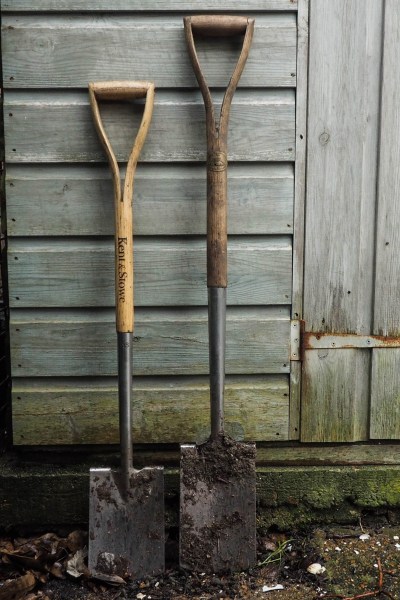
The spade on the left is smaller, lighter and has a smaller head. I find it better for my back than using the larger spade on the right.
(Note: links to Amazon are affiliate links, which means I may get a small fee if you buy, but it won’t affect the price you pay. Other links are not affiliate.)
And while we’re on the subject of spades, I have long been a ‘no dig’ fan. Adopting ‘no dig’ gardening practices will definitely lessen the strain on your back. Last August I interviewed ‘no dig’ guru Charles Dowding on using his veg growing principles in flower gardens.
His books and YouTube channel are a great resource for this environmentally-friendly, low-impact style of gardening.
‘And don’t fill your wheelbarrow,’ advises Denise. It may be tempting to pile as much compost or mulch on as possible, but a lighter wheelbarrow load is better for your back. You don’t have to buy a lighter wheelbarrow – just don’t fill it too full.
But what if you’re a professional gardener?
Professional gardener Claire Vokins points out that it’s rarely practical for a professional gardener to do twenty minutes of one job, then twenty of another.
And RSI is an issue for professional gardeners, as well as back or knee pain. As a professional writer, I have suffered from RSI, although not the same RSI as a gardener would get.
I strongly advise – and this comes from bitter experience – that you get advice on the correct position and tools so you can do your job safely. RSI creeps up on you over several years, and it can take just as long to get rid of it. Don’t ignore twinges.
A good gardening qualification should include advice on how to do the job safely. There are also health and safety courses from the British Association of Landscape Industries, and other associations such as the Gardeners’ Guild and the Association of Professional Landscapers.
And a chartered physiotherapist will also be able to give you advice.
Easy exercises for back pain from gardening
When you get in from gardening, lie down. On the floor rather than the sofa!
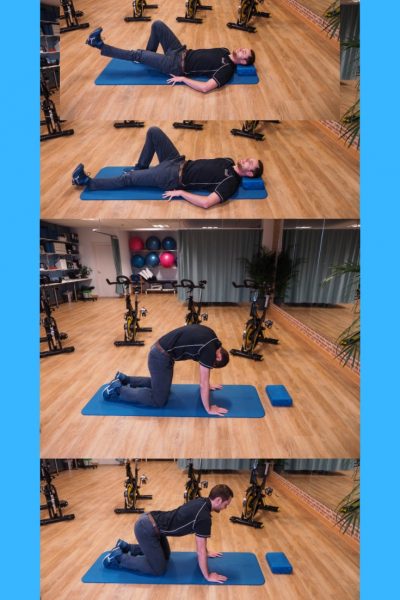
Charlie of Kesson Physio demonstrates a knee exercise (top) and a back exercise.
In this video, Denise has shown me the best exercises to ease back pain from gardening and for strengthening knees.
If you want to fast-forward straight to the exercises, the back exercises are at 2 minutes 11 seconds, and the knee exercises are at 7 minutes 40 seconds.
What about gardening knees?
One way of easing the strain on your back when gardening is to kneel for tasks like weeding. But if you also have dodgy knees, that can be a problem, too.
However, it’s rare for gardening to cause knee problems. ‘We see people coming in because an issue with their knees limits what they can do in the garden,’ says Denise. ‘It’s less likely that someone will come in with knee damage that’s caused by something they did in the garden.
Denise advises using a kneeler to soften the impact. It needs to be well padded, but otherwise it’s a question of choosing a kneeler you find comfortable.
I sometimes use a cushion-type kneeler. A friend gave me an RHS kneeler ten years ago and it’s still going strong. The only disadvantage is that you have to pick it up and carry it with you everywhere. I find I forget it, and then it gets wet.
So we decided to try knee pads. These are individual pads which strap onto each knee. I researched the three most popular brands on Amazon – the No Cry Professional Knee Pads, the Burgon & Ball Memory Foam Garden Kneelo Knee Pads and Cate’s Garden Knee Pads. I bought all three.
Which brand of knee pad?
Mr Middlesize particularly likes the heavy duty No Cry Professional Knee Pads, especially when he is weeding a gravel path. They are the sort of knee pads that construction workers wear on a building site.
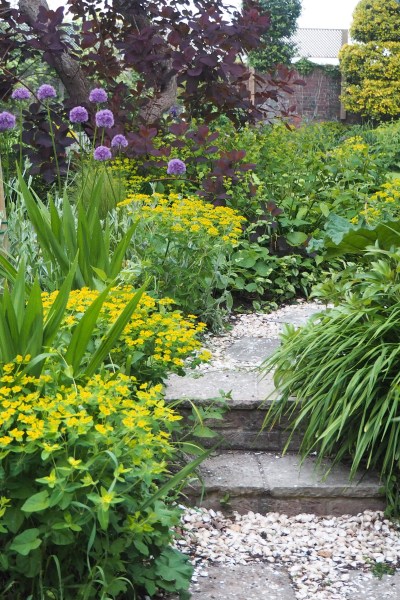
Mr Middlesize wears No Cry heavy-duty construction-site knee pads when weeding this seashell path.
However, for lighter work, he automatically reaches for Cate’s Garden Knee Pads. Burgon & Ball’s knee pads are stuffed with Memory Foam and Cate’s Garden Knee pads with expanded polyethylene (EPE). Both are covered with Neoprene and tied on with Velcro-type straps. I find them both equally comfortable and use them interchangeably, although Mr M prefers Cate’s.
We’ve used all three regularly for a year with no obvious signs of wear in any of the three brands.
However, you must put them on the correct knee or the Velcro straps may get entangled and stick your knees together. I cannot be the only idiot who has nearly come crashing down because I put my knee pads on wrong!
I now use Genus gardening trousers with integral knee pads – there’s more about that in Brilliant Gardening Trousers and Other Useful Kit.
When should you see a physio?
If your muscles ache the day after gardening, then Denise says it’s likely to be muscle soreness. You may be able to help it with a hot bath or shower. ‘But if there is an unfamiliar pain, pins and needles or something that worries you, it’s better to see a physiotherapist sooner rather than later. We see a lot of people who have been trying to manage their pain themselves and it hasn’t worked.’
Above all, she says, gardening is a very physical activity, so everything you can do to make yourself fit for it will help. If you are office-bound all week, then getting fit in other ways – the gym, Pilates, yoga and other exercises – will help prevent injuries.
PS I’ve been doing Denise’s knee exercises over the last week. An irritating twinge in my right knee has now departed.
Pin to remember how to prevent knee and back pain from gardening
And do join us. See here for a free weekly email with more gardening tips, ideas and inspiration.
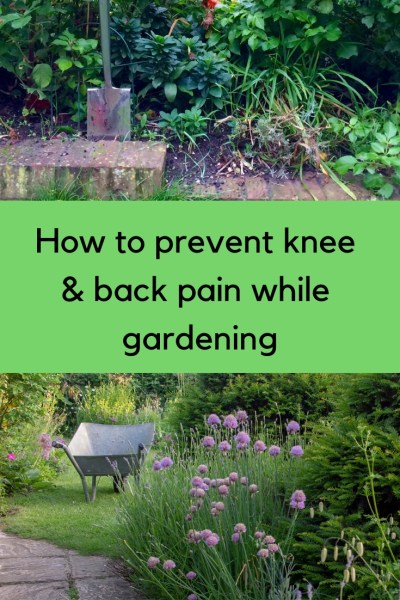
























On the subject of using a wheelbarrow, I learned that if you have most of the soil or what have you at the tipping end, it will appear to be much lighter and is easier to manage.
Interesting, thank you.
I’m testing this once again! I tried to leave a comment yesterday, both on Safari and then Chrome and neither seems to have gone through….. Let’s try again!
For the benefit of other readers, there seems to be a problem with leaving a comment when you visit this website on the Safari browser, although leaving a comment through Chrome seems to get through (even though sometimes it says it doesn’t). I’ve notified my web designer and he is looking into it, but it is a problem for other blogs too. Thank you for persisting!
THis is a wonderful and very timely post! After thumb/hand surgery two m onths ago I am still in part time brace and doing strengthening exercises. And then, my foot developed a stress fracture so I’m in a knee high boot…hopefully that comes off in another week! But it’s the hand that may be the biggest bother as I start gardening again. I’m looking into arthritis products for all sorts of tools, gloves to fit over the brace and on and on! I have been doing these lower back exercises for a few years and yes! they really work. Thank you for this post…and I will be doing a sort of similar one in a few months as the season gets going!
I’ll keep an eye out for that as the arthritis products are interesting – leave another comment on this post with a link when you do it as I’m sure people reading this would like to see it. (the comment did get through!)
Thankyou for this helpful post, it is just what I need.
Sarah
Thank you!